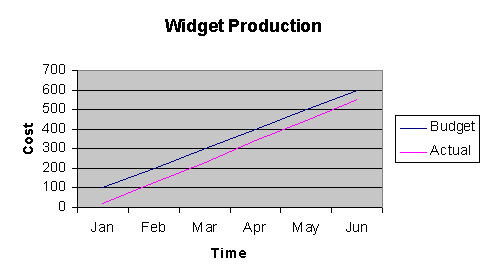
Earned Value Metrics in CET
Contents
- Financial terminology
- Team accounting
- Earned Value Metrics
- Glossary
Overview
Earned Value Management is a methodology used to measure the real physical progress of a project taking into account the work complete and the costs incurred to complete that work. Earned Value helps evaluate and control project risk by measuring project progress in monetary terms.
Without Earned Value, financial figures alone may give falsely read 'under budget' when we are actually heading for an overspend situation.
Example
This is illustrated with the following simple example. Imagine you are responsible for a project to build widgets. You plan to build 1 widget a month over a 12 month period, and you estimate each widget will cost 100 CHF to produce. After 6 months you look at your financial report and see:

This financial report on its own looks very promising. After 6 months you had planned to incur 600 CHF of costs (6 widgets @ 100 CHF/widget), but you have only incurred 550 CHF of costs.. it looks like you are under budget!
EVM metrics
Planned Value is the amount of work scheduled measured in CHF. For example if you plan to build 1 widget a month at 100 CHF a widget, then your PV after 6 months is 600 CHF.
Earned Value is the actual amount of work performed measured in CHF. For example if after 6 months you have built 5 widgets (planned at 100 CHF/widget) then your Earned Value is 500 CHF.
Actual Cost is the actual cost incurred to perform the work (in CHF). For example if after 6 months where you planned to build 6 widgets at 100 CHF/widget, you may find that your actual costs are only 550 CHF. Actual costs alone cannot tell you the health of a project because for the 550 CHF you don't know if you actually built all 6 widgets or only 1 widget. (If all six then well done, you are on-schedule and under budget, but if only 1 then you have an overrun of some 550%!)
Cost Variance is calculated using Earned Value - Actual Costs. If for example you have built 5 widgets at a planned cost of 100 CHF/widget and your current actuals show you have spent 550 CHF then there is a cost variance of -50 CHF. Negative cost variance indicates cost overrun.
Cost Performance Index is the ratio of Earned Value to Actual Costs. If you have built 5 widgets (planned at 100 CHF/widget) then your EV is 500, and say your actual costs show 500 CHF then your Cost Performance Index is 500/550 = 0.90%. Basically the cost performance index indicates the amount of work you are achieving for every CHF of cost your are incurring. A CPI of 90% indicates that for every CHF spent you are achieving 90% of the work. If you wish to extrapolate then you can say that instead of your planned 100 CHF per widget, every time you spend 100 CHF you are only building 90% of a widget, so the real cost of a widget is around 110 CHF and not the planned 100 CHF. The cost performance index is vital for extrapolating to determine how much over budget you will be if performance doesn't improve.
Conclusion
While the financial report alone looks 'healthy' (under budget), by including the measurement of real work performed we see that in fact we are not in a healthy situation, but we are behind-schedule and will be over-budget if we continue at the same rate.